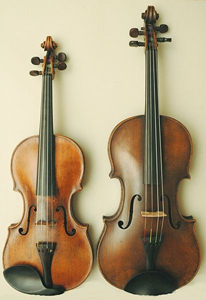
BASIC PLAYING TECHNIQUE
In its standard playing position, the viola is supported between the chin and left shoulder. The neck of the instrument is situated between the thumb and palm of the left hand, and the left elbow is held far to the right so that the fingers fall almost perpendicularly on the strings. The bow is held between the fingers and thumb of the right hand. Varying pressure is applied to the bow by the index finger. Balance is achieved by the little finger. The hair of the bow is drawn at right angles to the string, about halfway between the bridge and the end of the fingerboard. To play high notes or to produce a louder, more brilliant tone the player bows the string closer to the bridge. To play softer tones, the strings are bowed closer to or even over the fingerboard.
VARIETIES OF ARTICULATION/OTHER PLAYING TECHNIQUES
(Here the material associated with the violin would apply here.)
THE VIOLA BOW
Foreign names: Fr., archet; Ger., Bogen; It., arco \Dimensions--Stick: 28.5 inches. Hair: 24 inches
Dimensions to be inserted:
Overall length: approximately 27 inches.
Body length: 16 5/8 inches.
Neck length: approximately 6 inches.
Sounding length of the strings, from nut to bridge: just over 15 inches.
Here is a picture of the violin (on left) as compared with viola (on right)

As an example of the viola's sound, here is a passage from the conclusing section of Flos Campi "Flowers of the Field" by Vaughan-Williams, a work for solo, viola, wordless chorus and orchestra. Notice how the instrument is being played in its lower register where it has a richer tone than the equivalent register on the violin.
CHANGES IN CONSTRUCTION AFTER 1830
The viola underwent structural changes similar to the violin shortly before 1800. [From here on, info about changes continues as in violin section.]
VIOLA TRIVIA
If the viola were larger in exact proportions to the violin according to the instrument's lower pitch, the instrument would have to be substantially longer than it is, making it barely playable. Viola virtuoso William Primrose said in this regard, "The viola is difficult enough without having to indulge in a wrestling match with it."
"The viola is a philosopher, sad, helpful; always ready to come to the aid of others, but reluctant to call attention to himself."
Albert Lavignac
An Encyclopedia 01-Quotations About Music, op. cit.
Johann Quantz wrote the following comment regarding the place of the viola in music in 1752, during a time when little repertoire had been created especially for it. "The viola is commonly regarded as of little importance in the musical establishment. The reason may well be that it is often played by persons who are either still beginners in the ensemble or have no particular gifts with which to distinguish themselves on the violin, or that the instrument yields all too few advantages to its players, so that people are not easily persuaded to take it up. I maintain, however, that if the entire accompaniment is to be without defect, the violist must be just as able as the second violinist."
The Viola is not merely "a big Violin." It is a Viola. (Cecil Forsyth, Orchestration, 1914)
The instrument of mixed sex ... this hermaphrodite of the orchestra. Beecham, Sir Thomas, A Mingled Chime (1944).
The viola is commonly (with rare exceptions) played by infirm violinists, or by decrepit players of wind instruments who happen to have been acquainted with a string instrument once upon a time.
Richard Wagner (1869), quoted in Gattey, Peacocks on the Podium (1982) .
Physically it is only one-seventh larger than the violin, and its tone lacks the brilliance of the violin without having the deep philosophical quality of the cello. It is no wonder, therefore, that the viola rarely plays a leading part in chamber music or in the orchestra. Slonimsky, Nicolas, Lectionary of Music, Mc Graw Hill Publishing, New York, 1989.
Suggested viola works for further listening
BARTOK: Viola Concerto
BERLIOZ: Harold in Italy
HINDEMITH: Der Schwanendreher, for Viola and Orchestra
MOZART: Sinfonie concertante in E-flat for Violin and Viola, K.364
TELEMANN: Viola Concerto
VAUGHAN WILLIAMS: Flos Campi, for Solo Viola, Chorus and Orchestra
WALTON: Viola Concerto
If you need to leave, Go to initial page of site.
If you are interested in advertising a music-related business in the pages of the classroom, please send us an e-mail regarding rates by clicking here.